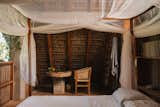The Deep Dive: A History Overhead
As any issue of Dwell proves, the choice of material or joinery method can transform a good project into a design for the ages. The Deep Dive is a forum where design and building pros can obsess over those details. Here we ask expert colleagues to share the inspiration behind house elements that delight clients—as well as the nitty-gritty information about how they were built.
The residence featured in our May/June issue story, "An Artist Lets the Wind and Wildlife of Oaxaca Flow Through Her Radically Open Home," straddles past and present. The building’s showstopper element is a palapa, or palm-leaf-thatched roof, whose origins date to prehistoric housing. Meanwhile, the space underneath it is open to passersby and the elements in an utterly modern way.
The very concept of a roof is only about 42,000 years old, and archaeological evidence shows that many of the world’s oldest enclosures were made of foraged plant material. By the Mesolithic Age, as agriculture became more widely practiced, thatching had become a sophisticated craft—a technique that was adapted to a site’s available materials, and which families would pass down through generations.
The evolution of thatching into a craft tradition had taken place in most Mesolithic societies, except those of ancient Oaxaca. The region’s Zapotec and Mixtec people were not exposed to Mayan architecture, which made significant use of thatching composed of palm, straw, and reed, so the technique did not arrive in Puerto Escondido’s vicinity until the 16th century. That’s when the Spanish conquest imported thatching from the colonial Philippines, where the Indigenous people used it to finish the stilt-raised homes known as Bahay Kubos.
Whereas palapa is Tagalog for palm leaf, in Oaxaca the term became synonymous with an entire open-air structure topped in a pyramidal or umbrella-shaped thatched roof. Lasala conceived Deborah’s project as an A-frame, to distinguish it from Mexican convention, by dramatically increasing the angles of the roof. "One of the reasons I made the roof that steep is because palapas can get rotten easily without ventilation," she says, so the roof’s angle emphatically shucks water away from the building. "I also wanted some part of the roof to almost touch the ground," she notes, which further demanded good drainage away from the site.
Although Deborah’s house is unconventional in design as well as construction—it employs impregnated pine in lieu of local macuil timber, for example—it was assembled like any palapa. Craftsmen threaded palm leaves through an armature, working from bottom to top. Whereas a typical, gently angled roof would allow Oaxaca’s palapa artisans to do this binding and weaving directly on the assembly, the crew reporting to Deborah and Lasala reached the A-frame via temporary platforms and walkways.
Combining ancient material and contemporary architectural expression, Lasala says, ultimately allows Deborah and her guests to appreciate the thatching more closely than they would in a vernacular palapa. "From the outside, a palapa roof is not enticing, it looks hairy," she says. "Inside this house you see all the craft, and how beautifully it’s done."
Published
Topics
The Deep DiveGet the Pro Newsletter
What’s new in the design world? Stay up to date with our essential dispatches for design professionals.



